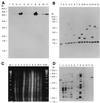Conditionally replicating mycobacteriophages: a system for transposon delivery to Mycobacterium tuberculosis
- PMID: 9380742
- PMCID: PMC23545
- DOI: 10.1073/pnas.94.20.10961
Conditionally replicating mycobacteriophages: a system for transposon delivery to Mycobacterium tuberculosis
Abstract
Transposon mutagenesis provides a direct selection for mutants and is an extremely powerful technique to analyze genetic functions in a variety of prokaryotes. Transposon mutagenesis of Mycobacterium tuberculosis has been limited in part because of the inefficiency of the delivery systems. This report describes the development of conditionally replicating shuttle phasmids from the mycobacteriophages D29 and TM4 that enable efficient delivery of transposons into both fast- and slow-growing mycobacteria. These shuttle phasmids consist of an Escherichia coli cosmid vector containing either a mini-Tn10(kan) or Tn5367 inserted into a nonessential region of the phage genome. Thermosensitive mutations were created in the mycobacteriophage genome that allow replication at 30 degrees C but not at 37 degrees C (TM4) or 38.5 degrees C (D29). Infection of mycobacteria at the nonpermissive temperature results in highly efficient transposon delivery to the entire population of mycobacterial cells. Transposition of mini-Tn10(kan) occurred in a site-specific fashion in M. smegmatis whereas Tn5367 transposed apparently randomly in M. phlei, Bacille Calmette-Guérin (BCG), and M. tuberculosis. Sequence analysis of the M. tuberculosis and BCG chromosomal regions adjacent to Tn5367 insertions, in combination with M. tuberculosis genomic sequence and physical map data, indicates that the transpositions have occurred randomly in diverse genes in every quadrant of the genome. Using this system, it has been readily possible to generate libraries containing thousands of independent mutants of M. phlei, BCG, and M. tuberculosis.
Figures



References
-
- Murray C J L, Styblo K, Rouillon A. Bull Int Union Tuberc Lung Disorders. 1990;65:6–26. - PubMed
-
- Murray C J L, Lopez A D. Global Burden of Diseases. Cambridge, MA: Harvard Univ. Press; 1997. p. 273.
-
- Sudaraj C V, Ramakrishnan T. Nature (London) 1971;228:280–281.
-
- Kleckner N, Bender J, Gottesman S. Methods Enzymol. 1991;204:139–180. - PubMed
Publication types
MeSH terms
Substances
Grants and funding
LinkOut - more resources
Full Text Sources
Other Literature Sources

